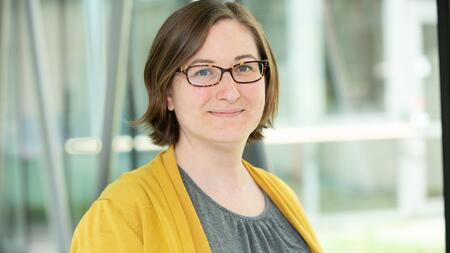Vaccinated against polio - or not?
HZI study on digital cohort shows differences between documented and self-reported polio vaccination rates
DZIF scientist Dr. Carolina Klett-Tammen, deputy head of Clinical Epidemiology in the department "Epidemiology" at the Helmholtz Centre for Infection Research (HZI)
Poliomyelitis, also known as polio, is a contagious disease caused by the poliovirus. Thanks to the development of effective vaccines, the poliovirus has been largely eradicated and was endemic in only two countries in 2024. However, until the virus is eradicated worldwide, vaccination protection is important in Germany as well, as the virus could be reintroduced at any time. Epidemiologists at the Helmholtz Centre for Infection Research (HZI) have now shown that many people do not know their vaccination status and cannot find it on their vaccination record. In an interview on the occasion of World Polio Day on October 24, DZIF scientist Dr. Carolina Klett-Tammen, deputy head of Clinical Epidemiology in the department “Epidemiology” at the HZI, explains the study results, which have been published in the journal BMC Public Health.
There have been no cases of polio in Germany for more than 30 years. What prompted you to look into polio vaccination protection in Germany?
We were prompted to take a closer look at the polio vaccination status by the report at the end of 2024 that the Robert Koch Institute (RKI) had found polioviruses in the wastewater of several major German cities. To do this, we used a cohort dataset that we already had on hand. We were very surprised by the result, as the vaccination rate was much lower than is generally assumed from population studies.
How did you then proceed to investigate the vaccination status in more detail?
More than 1000 participants in the PCR-4-ALL cohort study answered a questionnaire. With the help of this digital cohort, we are actually investigating testing strategies in outbreak situations in order to be better prepared for pandemics. During the cold season, the participants test themselves weekly for respiratory syncytial virus (RSV), influenza and SARS-CoV-2 and report whether they have symptoms via the digital HZI application PIA (Prospective Monitoring and Management App).
On the occasion of the discovery of polioviruses in wastewater, we investigated whether we could also examine the immunity status of the cohort at short notice. The test subjects provided us with information on both documented and self-reported polio vaccinations - i.e. those that they remember having received.
What did you find out when you evaluated the questionnaires?
For twenty percent of the participants, a self-reported polio vaccination is not documented in the vaccination record. If we try to determine the vaccination rate based on the vaccination records alone, we may underestimate it. In addition, for forty percent of documented vaccine doses, respondents were unable to identify from their vaccination record which polio vaccine they had received. Either this is not well documented or they cannot read it.
We also see from the self-reported uptake rates that the vaccination rate in the population should be higher to ensure effective protection of the population. But the most important finding of our study is the high differences between documented and self-reported vaccination rates.
What can someone do now if they are not sure whether they are sufficiently vaccinated against polio?
For German speakers, the RKI offers helpful decision trees to determine whether vaccination protection is complete. However, depending on the date of birth and the vaccines used, it is quite complex to determine whether you need a booster vaccination - as our study also shows. My recommendation is therefore to take your vaccination record with you to your next appointment with your family doctor and have it checked there.
A high vaccination rate is also important in countries like Germany that are currently polio-free. The goal is to eradicate polio globally. The annual World Polio Day on October 24 is also a reminder of this goal. We must therefore also identify hidden gaps in immunity in our country and try to tackle them. The first step towards this is the valid determination of vaccine-induced immunity in different population groups. The goal of eradicating polio worldwide can only be achieved through joint efforts - even in countries where the virus is not currently circulating.
Original release: on the HZI website
Additional information: Polioviruses in wastewater
A study by the Robert Koch Institute detected polioviruses in the wastewater of several major German cities at the end of 2024. This is not the wild poliovirus, which is only found in two countries in the world. Instead, the detected pathogens can be traced back to the oral vaccination with the attenuated but live virus (OPV). After the oral vaccination, the vaccine viruses can be shed by the vaccinated person for some time. If the attenuated vaccine viruses circulate for longer, they can undergo genetic changes in such a way that they can cause illness again. In Germany, a vaccine containing inactivated polioviruses (IPV) and administered by injection has been used exclusively since 1998.
Further links:
Informationen by the World Health Organization on World Polio Day

